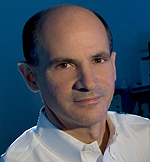5 Questions: Rando on resetting the ‘aging clock,’ cell by cell

Thomas Rando
Advances in the study of stem cells have fueled hopes that someday, via regenerative medicine, doctors could restore aging people’s hearts, livers, brains and other organs and tissues to a more youthful state. A key to reaching this goal — to be able to provide stem cells that will differentiate into other types of cells a patient needs — appears to lie in understanding “epigenetics,” which involves chemical marks stapled onto DNA and its surrounding protein husk by specialized enzyme complexes inside a cell’s nucleus. These markings produce long-lasting changes in genes’ activity levels within the cell — locking genes into an “on” or “off” position. Epigenetic processes enable cells to remain true to type (a neuron, for instance, never suddenly morphs into a fat cell) even though all our cells, regardless of type, share the same genetic code. But epigenetic processes also appear to play a critical role in reducing cells’ vitality as they age.
Bruce Goldman of the Office of Communication & Public Affairs recently talked to Thomas Rando, MD, PhD, professor of neurology and neurological sciences and director of the Glenn Laboratories for the Biology of Aging at Stanford, about the prospects for rejuvenating tissues by reprogramming the epigenetic settings of stem cells within those tissues. Rando and Howard Chang, MD, PhD, professor of dermatology, are co-authors of a review article on this subject published Jan. 20 in Cell.
Q: We can all see and feel the effects of our aging, gradually spreading throughout our entire bodies as time passes. Do these manifestations of growing older reflect some kind of a ticking “aging clock” inside our cells?
Rando: The effects that we notice reflect a combination of changes going on inside the cells in our tissues, as well as outside the cells — in the blood, the fluids that surround our brain and the protein lattices outside our cells in many tissues. In stark contrast to our early development, which is highly programmed and very precisely timed, we don’t all age at the same pace. There isn’t really a clock in the sense of some central “aging pacemaker.” Rather, the “aging clock” is more of a metaphor for the changes that occur in our cells and tissues with the passage of time. Aging seems to involve a gradual deterioration of function as cells and tissues are exposed to stresses either from outside the body, such as chemicals we ingest or irradiation from the sun, or from inside the body, such as free radicals, produced every moment when cells are making energy. These myriad insults can, among other things, alter a cell’s epigenetic settings, resulting in changed patterns of gene activity that diminish the cell’s overall ability to function.
Q: Is there evidence that cells’ age-altered epigenetic settings can be reversed?
Rando: Although some aspects of cellular aging — DNA mutations, for instance — would be difficult to “reset,” we and others have done experiments suggesting that many of the characteristics of old cells and tissues can indeed be reversed, restoring them to a more youthful state. Much of our work has focused on stem cells, and in particular on the changes that occur with age and that reduce stem cells’ ability to maintain or repair tissues. Our findings fit nicely with the idea that some of the causes of aging are epigenetic in character, as opposed to actual damage to genes. Most importantly, our data suggest that cells and tissues can be rejuvenated without losing their specific characteristics — old muscle stem cells, when rejuvenated, remain muscle stem cells rather than become some more generic, undifferentiated cell. This is in contrast to the field of induced pluripotent stem cells, or iPS cells, in which specialized cells, such as from skin or muscle, can be reprogrammed to become young, undifferentiated cells that can give rise to all kinds of cells — blood, skin, brain, nerve, you name it.
Q: Why might rejuvenating tissues directly, by reprogramming so-called “adult” stem cells within these tissues to a more youthful state, be a better way to go than using iPS cells or embryonic stem cells?
Rando: Being able to bring cells back to an “embryonic-stem-cell-like” state — as occurs with iPS cells — so they can produce, in theory, any cell in the body, holds tremendous potential. But iPS and embryonic stem cells’ capacity to differentiate into all the various cell types making up our bodies means they must be carefully guided toward their desired fate. Plus, because these cells can multiply indefinitely, unlike stem cells that reside in adult tissues, there’s a concern about potential tumor formation. We’re focusing instead on reprogramming tissue-specific adult stem cells — those that can make only muscle cells or nerve cells or blood cells — to be more youthful, which means they’ll be more effective at tissue maintenance and repair. There’s no risk that they’ll suddenly start making the wrong kind of cells. We don’t want stem cells in the heart to start making liver cells or pancreatic cells.
We think this is a very practical approach to the issues of aging, in which tissue maintenance declines and tissue regeneration in response to injury also declines dramatically. We would be using the cells that normally exist in that tissue rather than iPS or embryonic stem cells that don’t initially have the characteristics of the “adult” stem cells in a particular region.
Q: Work in your lab and in that of Tony Wyss-Coray, MD, PhD, professor of neurology and neurological sciences, has shown that factors in blood can speed or slow the aging process in at least some tissues by reprogramming stem cells in these tissues. What do you figure these factors are doing?
Rando: We are just beginning to test what we think is the answer to this question. Our recent work with Tony Wyss-Coray’s lab suggests that we can manipulate the “age” — the vitality — of cells in the brain, much as our own lab had previously shown we could manipulate the “age” of cells in muscles, the liver and blood. In all of these studies, we have identified “systemic factors,” molecules in the blood that are capable of reprogramming the age of the stem cells. We think they’re doing this by altering the epigenetic profiles of the cells. Now that we have evidence that the “age” of a cell is something that we can control to some extent, we aim to establish a biological definition of a cell’s age as opposed to a chronological one. So, we have started to look at young and old stem cells, asking, which of each cell’s genes are set in “off,” “slightly on” or “rampantly on” positions?
Q: If we get a handle on how to rejuvenate cells, might we be able to use that understanding to increase human beings’ healthy life span, even indefinitely?
Rando: Understanding the epigenetic features that make a cell young or old opens the door to the possibility of being able to control the age of a cell by controlling the processes that set up and maintain the epigenetic state. Of course, that’s at the level of cells. Would this translate into changes in longevity of the organisms? We don’t know. But clearly there must be a direct connection between the rate of aging of the cells and the rate of aging of the organism in which those cells reside.
Want To Re-Wind the Aging Clock? Change Your Environment!
